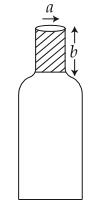Hooke’s Law MCQ - Practice Questions with Answers
Quick Facts
-
Hooke’s law is considered one of the most asked concept.
-
47 Questions around this concept.
Solve by difficulty
A wire elongates by $l \mathrm{~mm}$ when a load $W$ is hanged from it. If the wire goes over a pulley and two weights $W$ each are hung at the two ends, the elongation of the wire will be (in mm )
A bottle has an opening of radius a and length b. A cork of length b and radius (a + a) where (a<<a) is compressed to fit into the opening completely (See figure). If the bulk modulus of cork is B and frictional coefficient between the bottle and cork is µ then the force needed to push the cork into the bottle is :

Concepts Covered - 1
Hooke’s law states that if the deformation is small, the stress in a body is proportional to the corresponding strain, i.e.,
$\begin{gathered}\text { Stress } \alpha \text { Strain } \\ \Rightarrow \text { Stress }=E(\text { Strain }) \\ \Rightarrow E=\frac{\text { Stress }}{\text { Strain }}\end{gathered}$
Where E is called as Modulus of elasticity and it depends on the nature of the material and temperature of the body and is independent of the dimensions of the body.
Unit of Modulus of elasticity= N/m2
- Modulus of elasticity is of three types:-Í
- Young's Modulus(Y):- It is defined as the ratio of longitudinal stress to longitudinal strain.
$$
Y=\frac{\text { longitudinal stress }}{\text { longitudinal strain }}=\frac{F / A}{\Delta L / L}=\frac{F l}{A \Delta L}
$$
b. Shear Modulus or Modulus of rigidity(G):- It is defined as the ratio of shearing stress to the shearing strain.
$$
G=\frac{\text { shearing stress }}{\text { shearing strain }}=\frac{F / A}{x / L}=\frac{F l}{A x}=\frac{F}{A \phi}
$$
c. Bulk Modulus(B):- It is defined as the ratio of volume stress to the volume strain.
$$
\begin{gathered}
\text { Volumestress }=\frac{F}{A}=\text { Pressure } \\
B=-\frac{P}{\Delta V / V}
\end{gathered}
$$
where $\mathrm{P}=$ increase in pressure, $\mathrm{V}=$ original volume, $\Delta V=$ change in volume
The negative sign indicates that with the increase in pressure, volume decreases by $\Delta V$.
- Compressibility(C):- The reciprocal of bulk modulus is called as compressibility.
$$
C=\frac{1}{B}=-\frac{\Delta V / V}{P}
$$
- Unit of compressibility:- N-1m2
- Poisson's ratio:- The ratio of lateral strain to longitudinal strain is called Poisson’s ratio (
).
- Lateral strain: The ratio of change in radius or diameter to the original radius or diameter is called lateral strain.
- Longitudinal strain: The ratio of change in length to the original length is called longitudinal strain.

$\sigma=-\frac{\Delta d / d}{\Delta l / l}$
where a negative sign is due to a decrease in the transverse length
Study it with Videos
"Stay in the loop. Receive exam news, study resources, and expert advice!"













